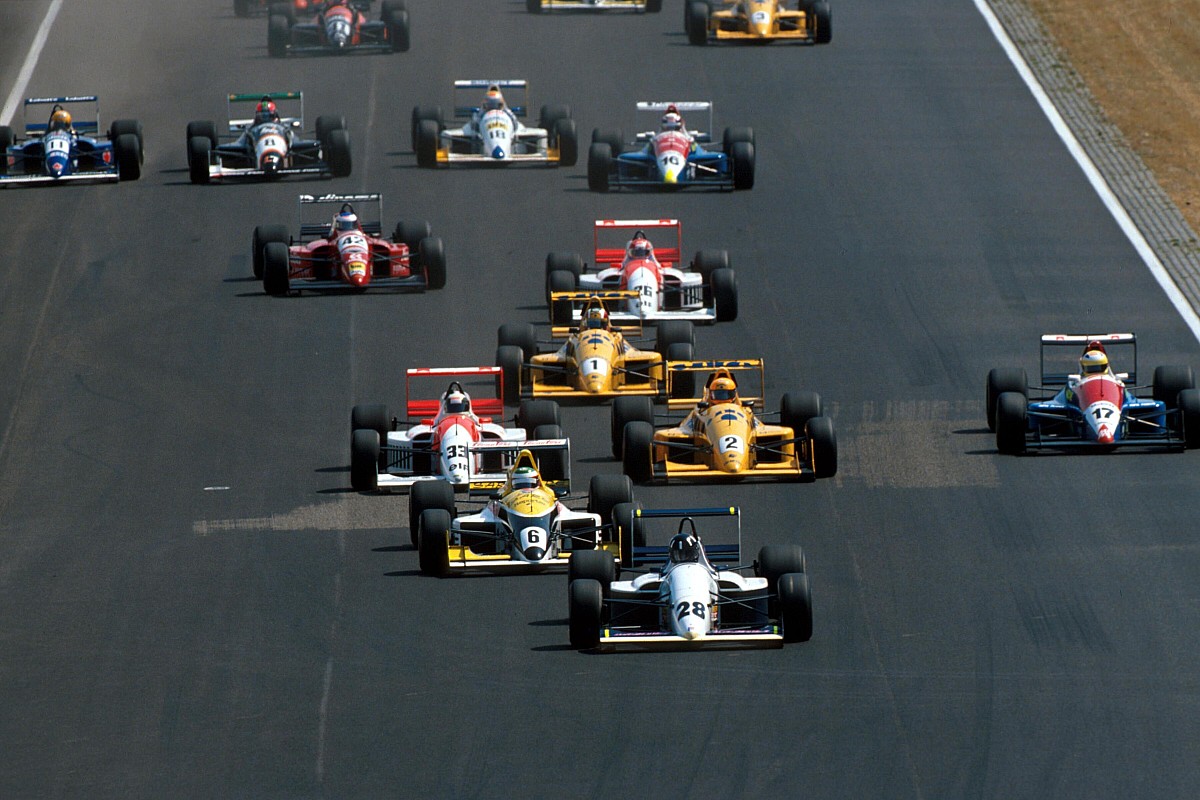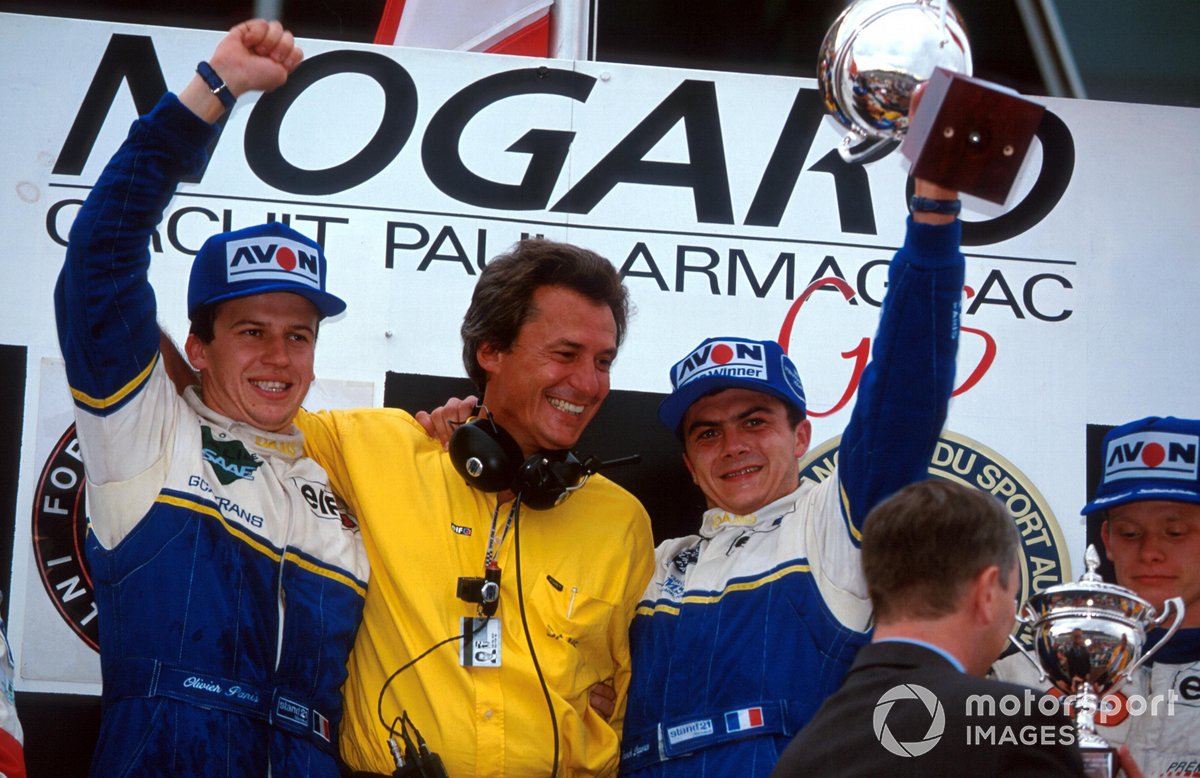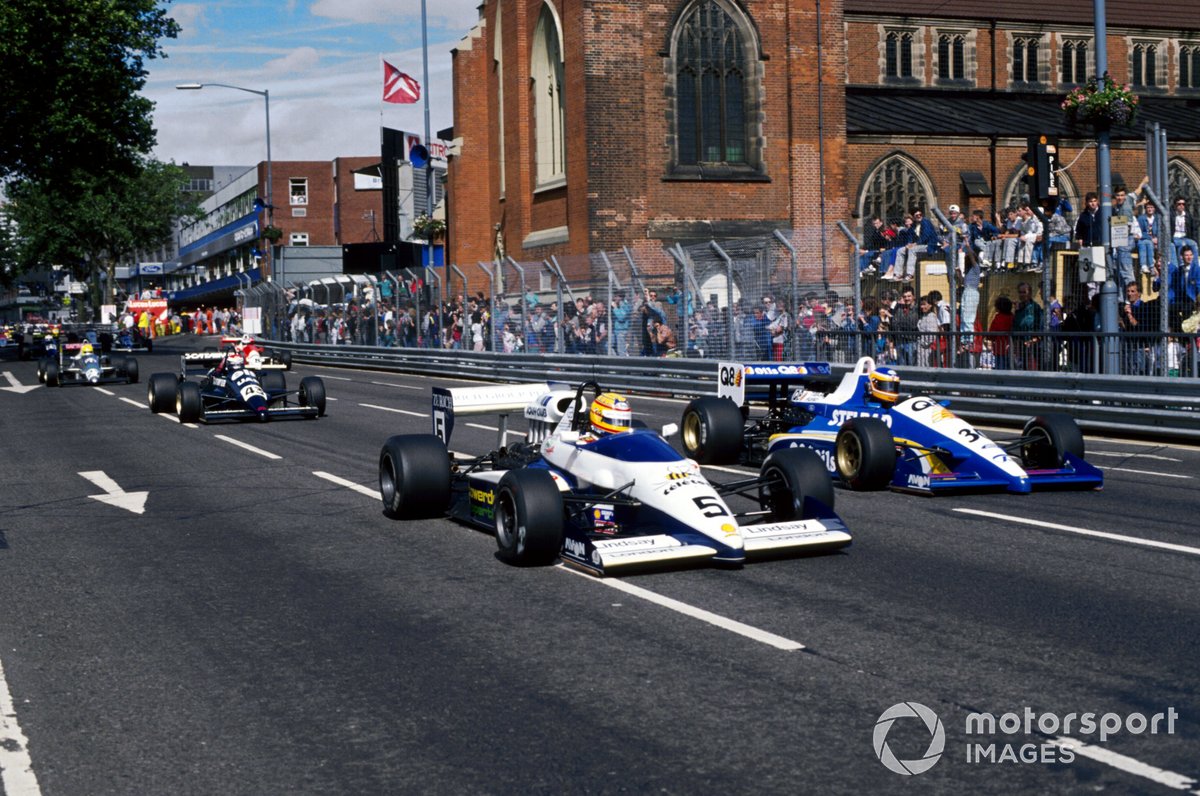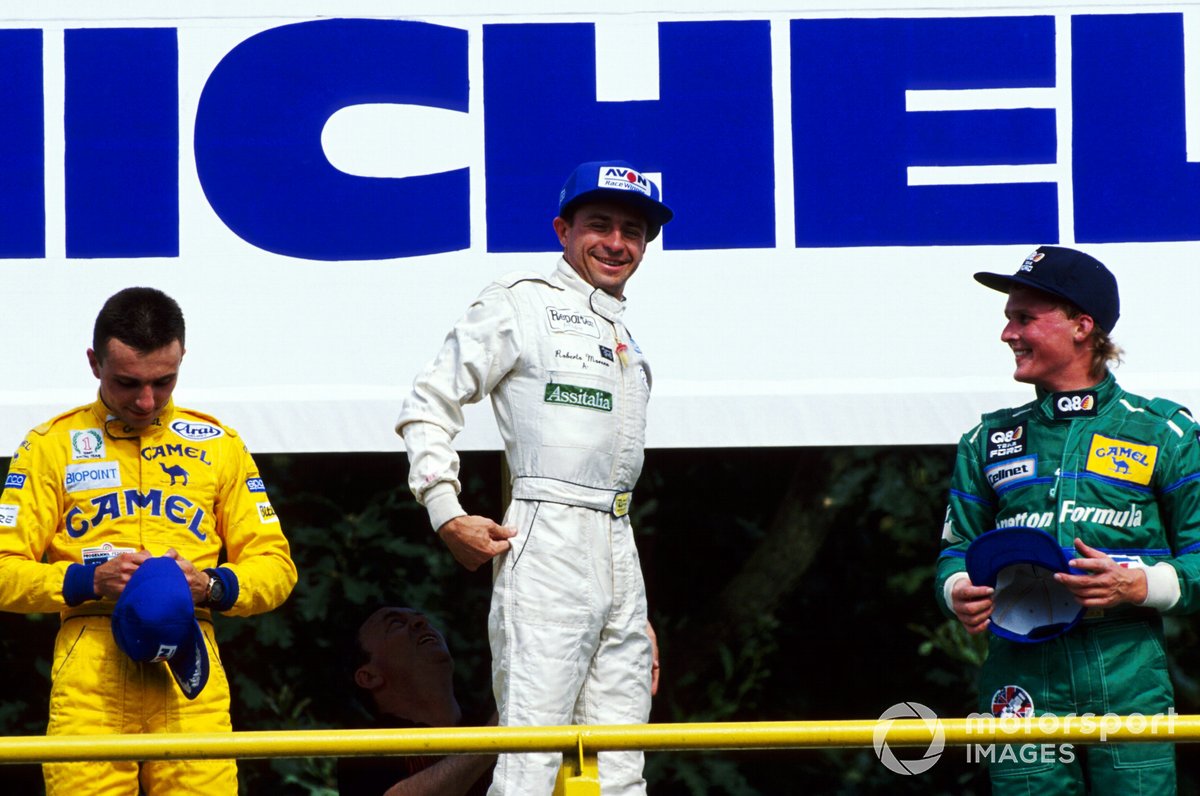
Philippe Alliott, Julian Bailey, Gregor Foitek, Olivier Beretta, Max Papis. All share a unique feat: their one visit to an International Formula 3000 podium resulted in victory.
That saves them from consideration for this list, ranking the best drivers to race in the main Formula 1 feeder series from 1985 to 2004 without standing on the top step of the podium.
For some, their lack of an F3000 win was no impediment to success at the top rung of the single-seater ladder, while others never made it onto a grand prix grid despite having demonstrated their ample talent.
To be eligible for this list, a driver had to have completed one season in the International championship. Therefore, 1992 Japanese champion Mauro Martini, who made three starts with Leyton House March in 1989, is not considered. Emphasis is placed on their performances in F3000 machinery, rather than subsequent achievement.
Here is Autosport’s ranking of the 10 best winless F3000 drivers, including an F1 world champion and one of Ferrari’s greatest team players.
10. Emmanuel Collard

Best Finish: 3rd (1992 Albacete, 1993 Nogaro)
Podiums: 2
Pole Positions: 1
Charging off into the distance at a soaking Magny-Cours in 1993, Emmanuel Collard looked set to finally end a disappointing year on a high. But a sudden wishbone failure as he negotiated the first corner tossed his Apomatox Reynard into the biggest crash of his career, splitting the concussed driver’s helmet and destroying the chassis.
The highly-rated Frenchman had fared well alongside team-mate Olivier Panis in 1992 as both grappled with Lola machinery that was not a match for Reynard. He only scored one podium, while Panis had two, but Collard finished ahead in the standings and was the closest of the pair to a victory. After Luca Badoer and Andrea Montermini had taken themselves out, Collard was pressuring new leader Jean-Marc Gounon in the Magny-Cours finale but was edged wide at the Adelaide hairpin and in the blink of an eye dropped from second to fifth before repassing Rubens Barrichello.
Apomatox made changes to the underfloor of its Reynard for 1993, which adversely affected its downforce and Collard struggled badly in qualifying that left him to fight for minor placings. When the mistake was rectified, he was suddenly a factor again for the final two rounds. He took pole by 0.42s over champion-elect DAMS driver Panis, and was just 1.1s behind winner Franck Lagorce in third at the Nogaro finale.
What could have been: The shootout that ended a Le Mans ace's F1 hopes
But it was already too late to save his hopes of F1 graduation for 1994, although he would go on to enjoy great success in sportscars, winning back-to-back Le Mans Series titles for Pescarolo alongside 1993 team-mate Jean-Christophe Boullion in 2005 and 2006.
9. Michael Bartels

Best Finish: 2nd (1992 Pau, 1992 Hockenheim, 1992 Nurburgring)
Podiums: 5
Pole Positions: 1
Michael Bartels’ best chance of an F3000 win disappeared when his Pacific Reynard spun on oil at Enna in 1993. The future FIA GT dominator had been a regular F3000 podium visitor in 1992, but couldn’t convert it into the ultimate prize of victory.
After a tough rookie campaign with his CoBRA Reynard in 1990, scoring just a single point in the Nogaro finale, Bartels had a disrupted 1991 season as he became unfortunate collateral in FIRST Racing’s contractual wrangle with the ousted Giovanni Bonnano. An attempted move into F1 with Lotus went awry, as the German failed to qualify for any of the four grands prix he entered with minimal testing, but he returned to F3000 for 1992 with the Crypton Reynard squad which gave him a truly competitive car for the first time.
Bartels initially outperformed Crypton team-mate Luca Badoer and drove to second at Pau, but he couldn’t hit the same heights as eventual champion Badoer thereafter, and struggled with reliability glitches after completing Crypton 1-2 finishes behind the Italian at both German rounds. Three mechanical-induced DNFs in the last three races ultimately dropped him to fourth in the standings, having been just six behind Badoer with three races to go.
Have a go hero: A GT1 legend's Group C one-off
Upon switching to Pacific for 1993, his third place finish at Silverstone was the only time he saw the chequered flag. There he’d been the closest challenger to runaway victor Gil de Ferran before slipping behind team-mate David Coulthard in the closing stages, and it was Coulthard who profited to take his only F3000 victory at Enna after poleman Bartels was caught out on oil dropped by Alessandro Zampedri’s expired Nordic Reynard.
8. Enrique Bernoldi

Best Finish: 4th (2000 Silverstone)
Podiums: 0
Pole Positions: 1
He’s best known for his unfulfilling and brief Formula 1 stint with Arrows, but Enrique Bernoldi twice lost F3000 victories in 2000 due to factors beyond his control which would likely have transformed perceptions of the Brazilian.
PLUS: The forgotten member of F1’s greatest rookie crop
Fresh from losing the British Formula 3 title to compatriot Mario Haberfeld, Bernoldi joined Helmut Marko’s Red Bull Junior Team for 1999 and peaked with fifth at Hockenheim. He’d also impressed in Barcelona, running fifth and ahead of eventual podium-finisher Andre Couto before being taken out by an errant Norberto Fontana.
And it was in Barcelona where Bernoldi took his first F3000 pole in 2000. He comfortably pulled away from David Saelens in the early stages, and appeared on course for what should have been a straightforward win. But a slow puncture put paid to that and meant he began a slow descent through the field that ended in a tangle with team-mate Ricardo Mauricio.
In the very next race, at the Nurburgring, Bernoldi qualified fourth but blasted into the lead at the start. He had survived two safety car restarts and was pulling away from the chasing Bruno Junqueira when his suspension failed, pitching him into the wall.
Thereafter, the only points he added to the fourth place he’d secured in a wet-dry race at Silverstone was a pair of sixths as he focused attentions on testing for Sauber. He ended the year 18th in the points, but had those two victories gone to Bernoldi and not to eventual champion Junqueira, the standings might have looked rather different…
7. Rubens Barrichello

Best Finish: 2nd (1992 Silverstone, 1992 Barcelona)
Podiums: 4
Pole Positions: 0
If Rubens Barrichello had eschewed a Jordan Formula 1 seat and returned to F3000 in 1993, he would almost certainly not be appearing on this list. The reigning British Formula 3 champion’s sole F3000 campaign was a picture of consistency and he was rewarded with third in the standings, with a victory the only missing ingredient.
Joining the Il Barone Rampante team that had thrust Alex Zanardi into the limelight the previous year, Barrichello was a charging runner-up on his debut at Silverstone where he formed part of an all-rookie podium with Jordi Gene and Olivier Panis.
He showed considerable maturity with an error-free drive to third at Pau, before finishing second to IBR team-mate Andrea Montermini at Barcelona after recovering from a bad start.
His trio of podium finishes from as many races gave the Brazilian the points lead, but it wasn’t to last as Luca Badoer benefitted from Crypton’s early adoption of the monoshock suspension and went on a winning run that catapulted him to the title. IBR switching from Judd to Cosworth engines couldn’t thrust Barrichello back into the championship frame, but brake failure-induced crash at Enna aside, he was never outside the points for the rest of the season.
Another third at the Nurburgring, as he followed the Crypton pair home, helped him to edge Badoer’s team-mate Michael Bartels for the bronze in the standings.
6. Darren Manning

Best Finish: 2nd (2000 Silverstone, 2001 Imola)
Podiums: 3
Pole Positions: 1
On both occasions that Darren Manning finished runner-up in an International Formula 3000 race, it was future grand prix winner Mark Webber who beat the Yorkshireman to the gold. But in what was effectively a one-car Arden team, with stablemate Victor Maslov a perennial tailender, Manning did a commendable job.
Arden certainly wasn’t the powerhouse it would become for 2002 during Manning’s spell with the team, but the 1999 Japanese Formula 3 champion formed a good relationship with engineer Mick Cook that helped establish ex-F3000 racer Christian Horner’s team as a frontrunner during his two-year stint. Consistency was a struggle in 2000 and he only scored twice, but both came from podium finishes.
What could have been: The F3 hotshot who twice turned down Japan
In only his second F3000 start Manning snared pole at Silverstone and led in the wet early stages before Webber caught and passed him on the drying track. Manning concedes that his parallel test duties with BAR were a distraction, but defying Webber for third at the A1-Ring showed further promise. And he won on his Italian F3000 debut using the older-spec cars at Enna, after pressuring team-mate Warren Hughes into a spin.
The following year he again took second behind Webber at Imola, harrying the Super Nova driver all the way to the flag, but it was his only podium of a disappointing year as he broke his front wing against Justin Wilson while third at Monaco and also broke his front wing shortly after taking third at Spa against the Bus Stop’s floppy corner markers.
Had he been kept on for a third season, given Arden’s upswing in form, it’s a reasonable assumption that Manning would have broken his duck in 2002. But he instead found himself pedalling stock cars in the ASCAR series before heading Stateside to Champ Car for 2003.
5. Mark Blundell

Best Finish: 2nd (1987 Spa, 1988 Jerez, 1988 Zolder)
Podiums: 5
Pole Positions: 0
Three times a runner-up in as many seasons of F3000, Mark Blundell demonstrated his credentials in just his third race. Running a year-old Lola for his 1987 rookie season, the Briton starred at a wet Spa as he overtook eventual champion Stefano Modena, then stormed into the lead past Roberto Moreno’s Ralt. He was overhauled by Michel Trolle’s GBDA Lola, but remained in the hunt as the track dried before red flags set the order early.
He'd already scored a point for sixth at Vallelunga after passing Andy Wallace late on, and repeated the feat at Brands Hatch, but struggled after switching to a newer machine for the remainder of the year.
A factory Lola driver in 1988, Blundell was the only driver in the same postcode as Johnny Herbert’s new Reynard at the Jerez curtain-raiser and avoided trouble on a black day at Brands Hatch to complete the podium. But his best drive that year came at Zolder, where he was only denied by an elbows-out Olivier Grouillard, the two nose to tail at the flag.
Second on the grid, he’d dropped behind the GBDA cars on the opening lap, but fought back past Jean-Denis Deletraz and pressed Grouillard all the way to the flag – finishing 0.2s in arrears – after leader Martin Donnelly lost gears. He also qualified second for the Dijon finale, but had a bad start and retired after contact with Bertrand Gachot while scrapping over third.
His 1989 campaign in the Middlebridge Reynard was disappointing, with third in the Silverstone opener after JJ Lehto was disqualified his only podium visit – although second was there for the taking at Pau until he was assaulted by Eric Bernard. Still, it didn’t stop him from making it to F1 and forging a fine career in US open-wheel racing.
4. Max Wilson

Best Finish: 2nd (1997 Hockenheim, 1997 Spa, 1998 Pau, 1999 Hockenheim)
Podiums: 7
Pole Positions: 2
Likeable Brazilian Max Wilson was undoubtedly the best driver of F3000’s early single-make years who didn’t manage to register a win.
Following his giant-killing ITC performance at Interlagos in 1996, Wilson enjoyed a strong rookie season in 1997 with the underdog Edenbridge outfit. He could have won on his debut at Silverstone as he was running ahead of eventual winner Tom Kristensen when his nose was damaged in a tangle with Jason Watt.
Wilson chased champion Ricardo Zonta home at Hockenheim and hounded Watt all the way to the flag in a thriller at Spa, where he was left to rue gear ratios that weren’t suited to the dry track and left him hitting the rev limiter on the Kemmel Straight.
He stuck with Edenbridge for an often-frustrating 1998 and lost second in the Oschersleben opener to a spin, having been jumped by an early-stopping Stephane Sarrazin, but was runner-up at Pau (albeit one lap behind winner Juan Pablo Montoya) with a faulty gearbox.
He twice claimed pole when new cars arrived for 1999 as he joined the David Sears-run Petrobras team, but was turfed off by a remorseful Nick Heidfeld while leading at Imola, and a missed gear at Hockenheim meant he lost out to team-mate Bruno Junqueira.
What could have been: A Williams F1 tester's Le Mans near-misses
Several races were blighted by an incorrectly-fitted differential, and he was controversially banned from Spa after a clash with Norberto Fontana – which came after being disqualified from Barcelona after an overly aggressive defence against unrelated namesake Justin. But the future V8 Supercars racer and Brazilian Stock Cars champion ended his F3000 career on a high on his comeback with a podium in the Nurburgring finale.
3. Michel Ferte

Best Finish: 2nd (1985 Estoril, 1986 Mugello, 1986 Le Mans)
Podiums: 9
Pole Positions: 2
The younger brother of fellow F3000 racer Alain, ORECA Marches driven robustly by the late Michel Ferte were regularly seen at the sharp end in the early seasons of the category. The 1991 Le Mans 24 Hours runner-up was in a leading position several times, but without ever taking the laurels.
He took pole and led the very first F3000 race at Silverstone in 1985 on a drying track, but his Avons couldn’t cope with the returning rain as well as Mike Thackwell’s Bridgestones (this being the only season when F3000 had rivalling tyre constructors). Despite a shunt in the worsening conditions, he hauled his damaged car home third as the best Avon runner.
After finishing a battling second and taking the points lead at Estoril, where his engine cutting out at one point left him convinced of retirement, Ferte led at Vallelunga until traffic allowed Emmanuele Pirro through and was charging up behind the Onyx March before his engine cut with overheated rev limiter. The same problem put the Frenchman out of a promising position at Zandvoort where he’d led the early laps, although he was due a penalty for jumping the start, while he also led from pole at Spa until crashing on the disintegrating track.
But Ferte came closest of all in 1986 at Mugello, where he harried winner Pierluigi Martini to the flag and came up just 0.4s shy. He’d also been pressuring Martini for the lead at Imola, only for his handling to go awry because of a puncture. His fighting spirit was on display in his other runner-up finish that year, at Le Mans, where he barged past team-mate Pierre-Henri Raphanel on the final lap.
2. Damon Hill

Best Finish: 2nd (1990 Brands Hatch)
Podiums: 2
Pole Positions: 3
An F1 world champion who never won an F3000 race, Damon Hill saw several opportunities go begging during a frustrating 1990 season in the Middlebridge Lola. Having wrestled the uncooperative Footwork the previous year onto the grid for every race he entered, no mean feat given Ukyo Katayama had twice failed to qualify, Hill took three poles in succession across the Monza, Enna and Hockenheim rounds but his only points finish of the year was a second place at Brands Hatch.
Friday favourite: The Williams that put Hill in an exclusive F1 club
He led at Silverstone until electrical failure hit, and again at Monza until plagued by misfires that prompted a change of spark box in the pits. Then at Enna, he led before spinning on a track surface that was rapidly deteriorating, and had got back to the front following a red flag before battery problems while running second put him out. A lap two spin while leading at Hockenheim was the only race he lost by his own doing.
Hill also led early at a wet Brands Hatch, and should have easily beaten Allan McNish given that the Scot was forced to stop twice due to a loose wheelnut. But the DAMS man’s earlier stop onto slicks and faster pace on a drying track, combined with a sluggish turnaround from Middlebridge, meant Hill could only finish second. The same issue blighted another potential podium finish at Nogaro, leaving him a lap down.
A Reynard was the car to have in 1991, but Hill compared favourably to his fellow Lola stablemates – finishing fourth at Vallelunga and a sodden Le Mans. He briefly led at Brands Hatch too, before tumbling back to sixth. Switching to a Reynard for the Nogaro finale, he showed what might have been possible by finishing third despite twice clashing with team-mate Vincenzo Sospiri (still in a Lola) while lapping him.
1. Marco Apicella

Best Finish: 2nd (1988 Monza, 1989 Pau, 1989 Birmingham, 1990 Jerez, 1990 Hockenheim, 1991 Mugello, 1991 Enna)
Podiums: 10
Pole Positions: 2
If Hill’s run of gutwrenching results in 1990 was bad, then spare a thought for Marco Apicella. The Italian has comfortably the most podium finishes of any driver never to win an F3000 race and finished second no less than seven times (including twice with the wretched 1991 Lola), while seeing plenty of other winning opportunities fall by the wayside.
Perhaps the best of those was Birmingham 1990, where his FIRST Reynard’s radiator was holed by a stone while leading Eric van de Poele. Apicella had also lost a certain victory to the Belgian earlier that year at Pau, where he crashed out of the lead, and the previous season had seen pole on the French street track go begging when he’d suffered a water leak on the grid. Forced to start from the pits, his recovery was stunning, and he finished second to Jean Alesi.
Apicella’s first season with the boxy EuroVenturini-run Dallara in 1987 didn’t offer many opportunities to run at the sharp end, although he did finish fifth by not stopping for tyres at Spa. Switching to FIRST for 1988, he was largely shaded by Pierluigi Martini with the unwieldy March that was heavily developed by Ricardo Davila, but took a distant second to Roberto Moreno's Reynard at Monza.
In his first time running a Reynard, having switched from March after a disappointing start to 1989 at Silverstone, Apicella qualified an excellent second at Vallelunga and after a suspiciously quick getaway looked set for victory until his engine seized to throw him off the road.
Eric Bernard’s ill-judged move on Mark Blundell at Pau helped him get back to second, a result he matched at Birmingham where he tracked winner Alesi all the way to the flag, while further podium finishes came at Jerez (the first Reynard home on a day of domination for the DAMS Lolas) and Spa after a stern defence against JJ Lehto with his engine cutting out.
Apicella twice finished second in 1990, losing out to Erik Comas at Jerez and Eddie Irvine at Hockenheim by a combined 6.1s, while further runner-up finishes went begging at Donington (fuel) and Enna (spinning on the treacherous track surface).
Switching to the new Paul Stewart Racing team for a fifth crack at F3000 in 1991, he was blighted by Lola’s disappointing T91/50 but still took back-to-back second places at Mugello and Enna before losing motivation in the final rounds and parking it at Spa.
PLUS: When a journeyman driver's F1 career lasted just 800m
Fortunately, he did right the wrongs of his International F3000 spell in Japan, where upon switching to the Dome team he finally broke his duck in 1992 at Autopolis. He went on to win the title in 1994 after a controversial clash with title rival Andrew Gilbert-Scott, and was also a race-winner in the nascent Italian F3000 series in 1999.








